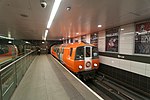Ibrox Park (1887–1899)
1887 establishments in Scotland1899 disestablishments in ScotlandDefunct football venues in ScotlandDemolished buildings and structures in ScotlandDemolished sports venues in the United Kingdom ... and 8 more
Football venues in GlasgowGovanRangers F.C.Scotland national football team venuesScottish Football League venuesSports venues completed in 1887Sports venues demolished in 1899Use British English from January 2016
Ibrox Park was a football ground in Ibrox, Scotland. It was the home ground of Rangers from 1887 until they moved to the adjacent second Ibrox in 1899. The ground staged the Scottish Cup Final four times and also three Scotland international matches.
Excerpt from the Wikipedia article Ibrox Park (1887–1899) (License: CC BY-SA 3.0, Authors).Ibrox Park (1887–1899)
Copland Road, Glasgow Ibrox
Geographical coordinates (GPS) Address Nearby Places Show on map
Geographical coordinates (GPS)
| Latitude | Longitude |
|---|---|
| N 55.8533 ° | E -4.3068 ° |
Address
Copland Road
G51 2UE Glasgow, Ibrox
Scotland, United Kingdom
Open on Google Maps









